Brief

Executive Summary
- Long-term prospects for the industrial Internet of Things remain ambitious. However, customers have struggled to implement some early solutions, and they now believe it will take longer to reach scale than expected.
- IoT vendors, including analytics firms, industrial technology makers and cloud service providers, can help customers by gaining deeper experience in industry-specific applications and offering end-to-end solutions.
- Vendors shouldn’t assume their industry experience gives them a strong competitive edge in IoT. They should partner with analytics firms and industry specialists to fill their gaps in knowledge and capabilities.
Two years ago, predictive maintenance was forecast to be one of the most promising uses of the industrial Internet of Things (IoT). Improving the ability to determine more precisely when equipment was at risk of failing, and to signal that risk to a system where it could be identified and repaired or replaced, seemed like a no-brainer. Who wouldn’t want better information to prevent equipment failure?
So it’s somewhat surprising that predictive maintenance has failed to take off as broadly as expected. A recent Bain survey of more than 600 high-tech executives has found that industrial customers were less enthused about the potential of predictive maintenance in 2018 than they were two years earlier. Conversations with many customers reveal that implementing predictive maintenance solutions has been more difficult than anticipated, and it has proven more challenging to extract valuable insights from the data.
Predictive maintenance is just one of many IoT use cases that customers have had difficulty integrating into their existing operational technology and IT systems. As companies in the industrial sector have invested in more proofs of concept, many have found IoT implementation more challenging than they anticipated. Because of this, customer expectations have dampened slightly (see Figure 1). Our 2018 survey found that, although the long-term predictions remain positive, in the short term, customers expect implementation to be a bit slower than they did in 2016. However, given the progress in sensor technology, 5G connectivity, edge computing and edge analytics, and an estimated 20 billion devices connected by 2020, there’s little doubt of the potential for technology to vastly improve efficiency and no doubt that the IoT will have to manage it.
The IoT outlook for 2020 has dampened, but long-term targets remain bullish
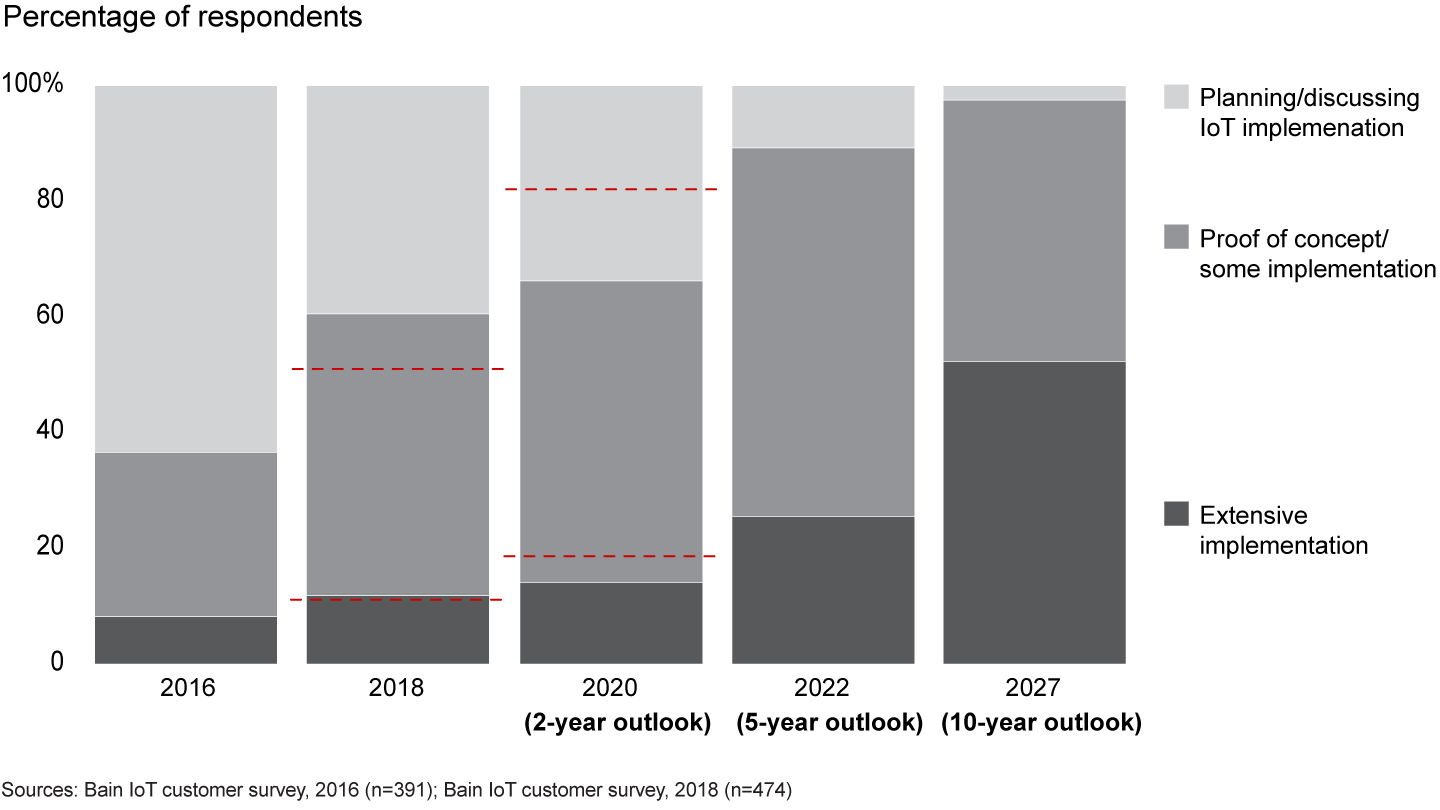
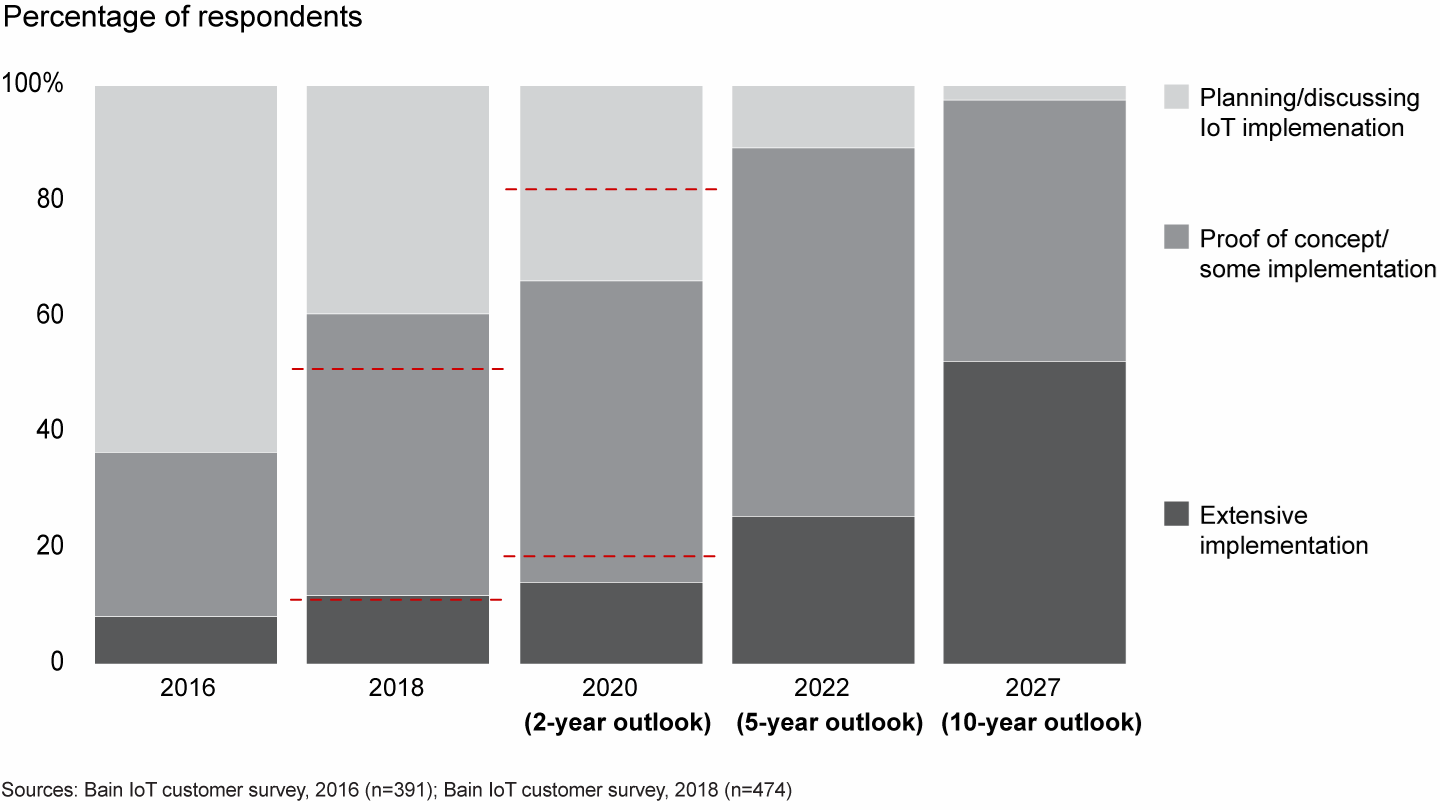
Overcoming adoption barriers
To reach those long-term goals, industrial IoT vendors should be helping their customers overcome the barriers to adoption. Bain’s 2018 survey found that among industrial customers, concerns over integration issues—in particular, technical expertise, data portability and transition risks—have become more acute over the past two years (see Figure 2).
More experience with proofs of concept has shifted IoT customers’ concerns in the past two years
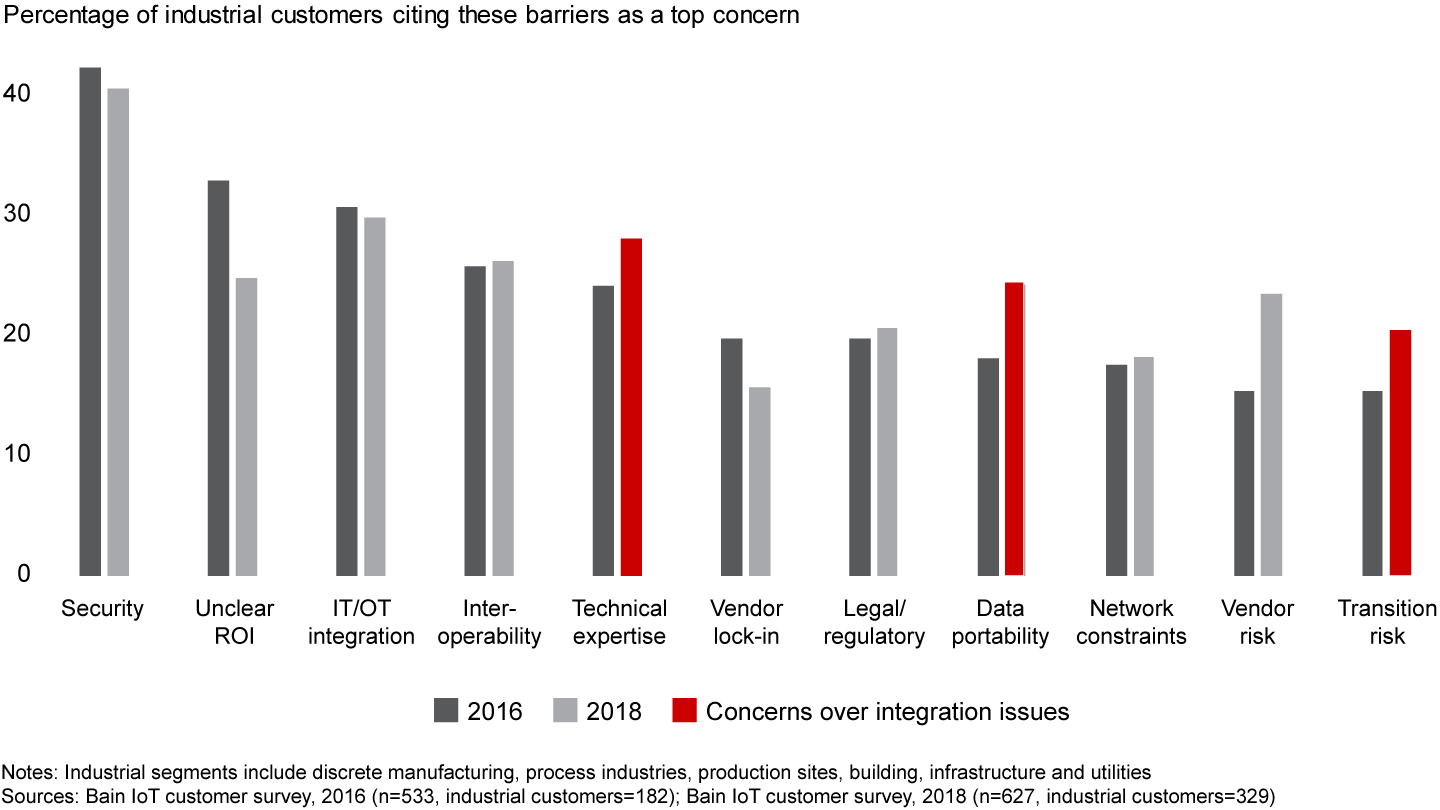
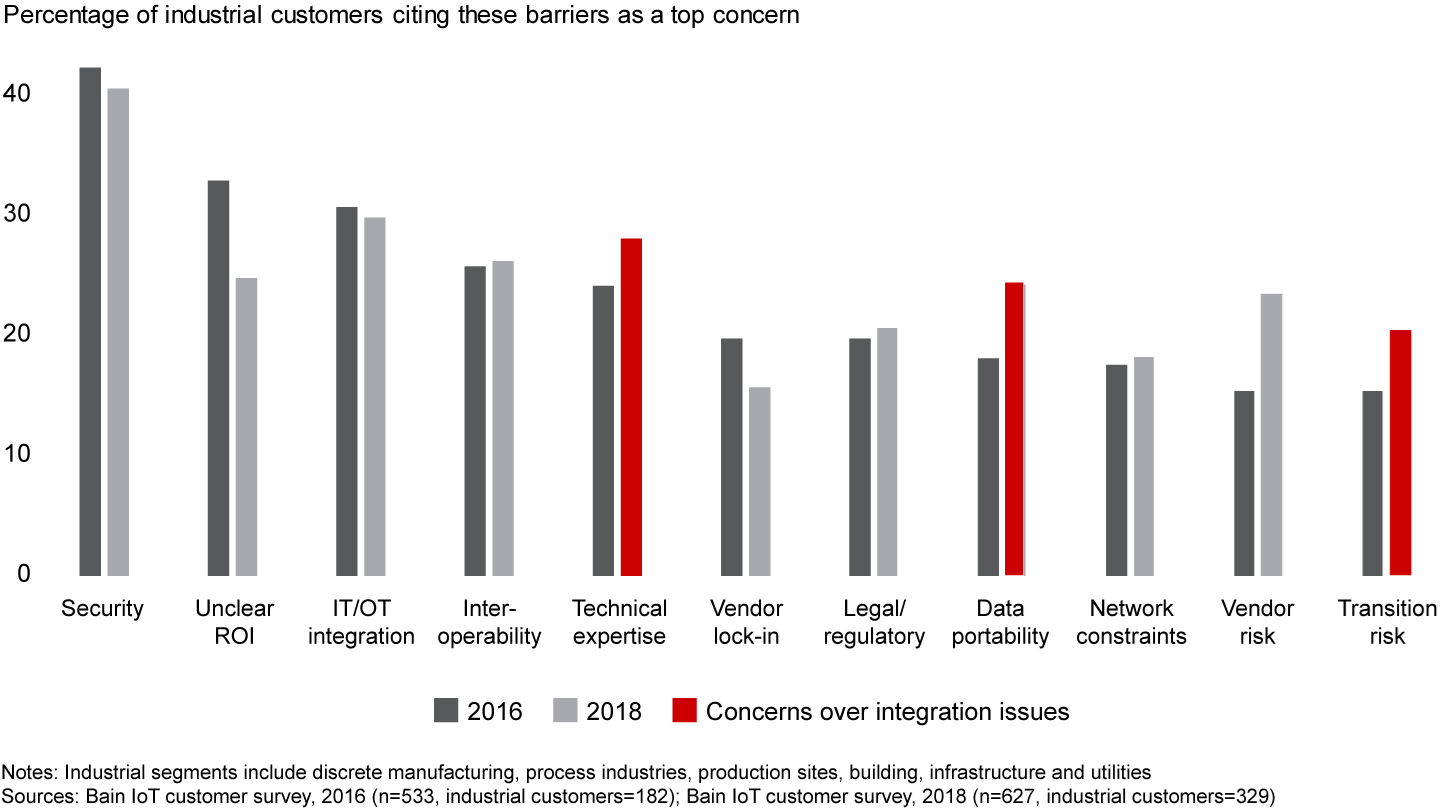
In 2016, customers were most concerned about security, returns on investment and the difficulty of integrating IoT solutions with existing IT and operational technology. In 2018, security and integration were still top concerns, indicating that tech vendors haven’t made much progress in addressing these. Our research has also found that as an organization becomes more technologically mature, concerns about security actually increase—so the challenge continues to grow. (For more on the subject, read the Bain Brief “Cybersecurity Is the Key to Unlocking Demand in the Internet of Things.”) However, fewer customers are concerned about ROI than two years ago, perhaps because they have been satisfied by the returns on their early implementations. Industrial IoT use cases are beginning to deliver vendors’ promises.
The issues that worry customers more are ones that arise during implementation: technical expertise, difficulties in porting data across different formats, and the transition risks. Proofs of concept have unearthed these challenges, and executives may now realize that although the effort pays off, the devil is in the details.
Gaining more industry expertise will allow industrial IoT vendors to help their customers overcome these barriers. To do that, they’ll need to align more closely with their customers’ expectations.
Aligning on use cases
So, which applications of IoT technology are gaining the most traction? To identify the most anticipated and promising use cases, we asked industrial IoT customers and vendors where they are in deployment on a wide range of applications. Several ranked high for customers and vendors both: quality control, remote monitoring of equipment and tracking of assets or equipment on production sites are a few examples (see Figure 3). We expect to see rapid growth in these applications, which appear in the top right corner of the chart.
Vendors and customers often differ over which use cases they value most
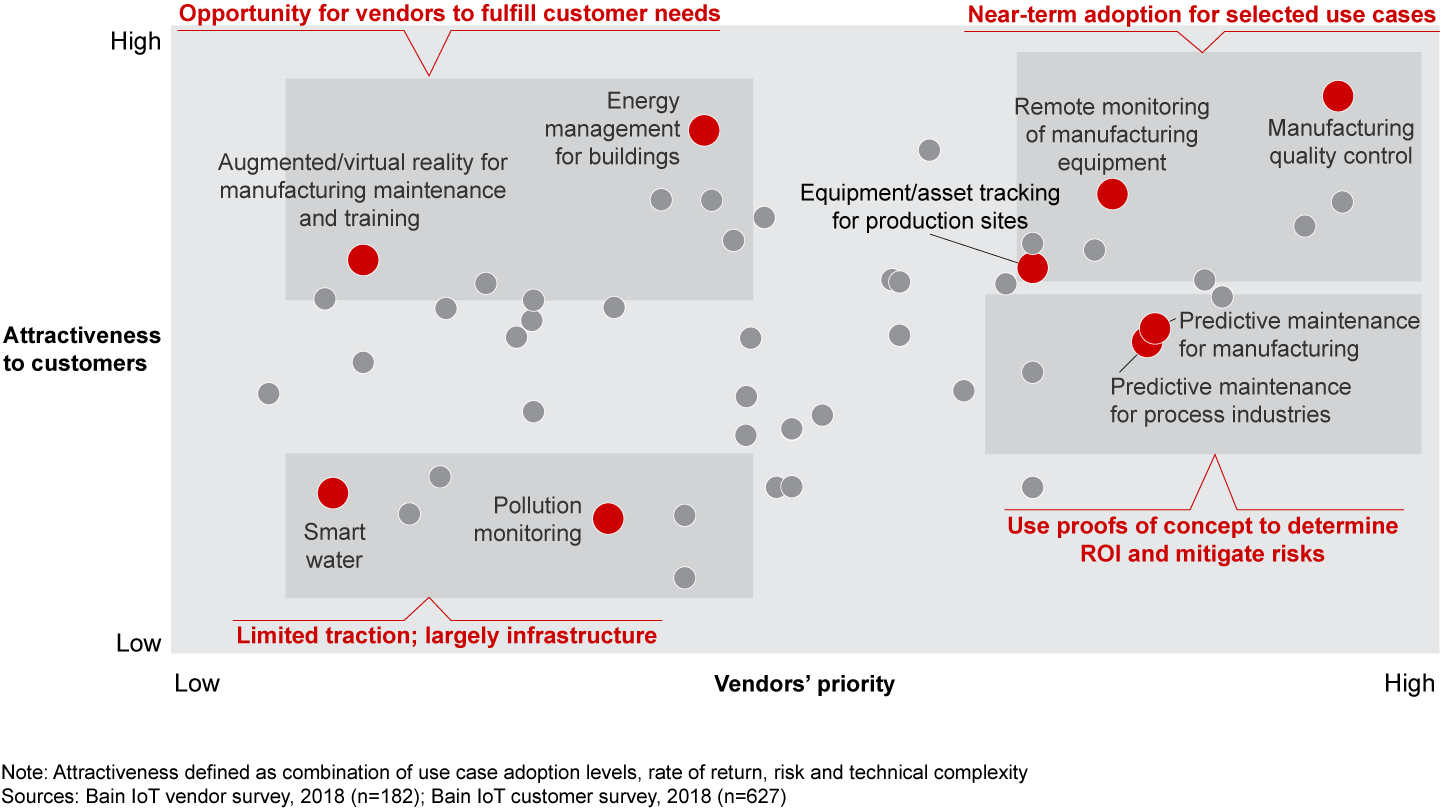
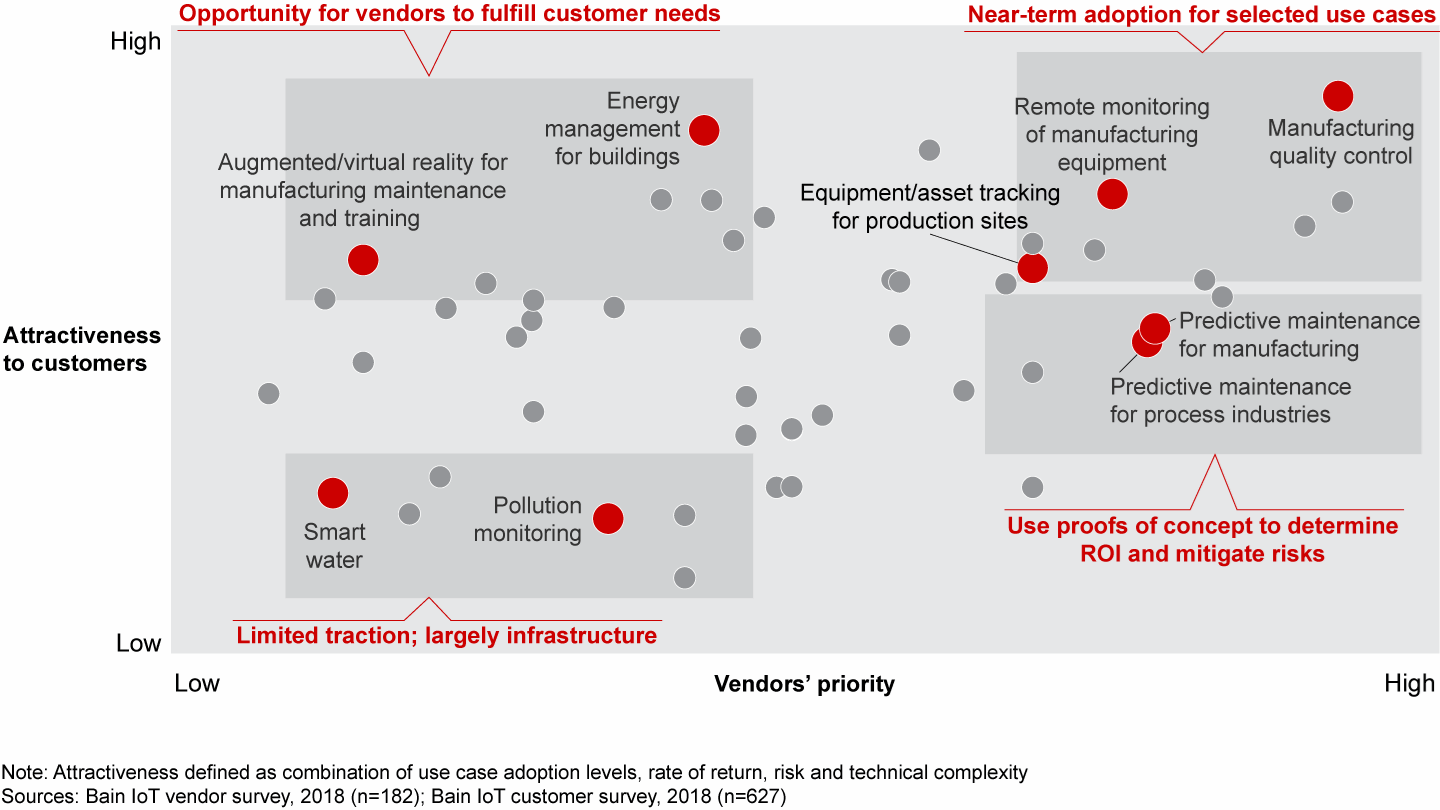
Predictive maintenance is the prime example of a use case that vendors are ready to deploy, but customers are less excited about, as shown in the middle right panel. Its decline in attractiveness indicates customers face implementation barriers. Vendors that want to boost adoption of these use cases need to focus on helping customers implement them.
Several others, including augmented reality and virtual reality for maintenance and training, and energy management, were among those that customers are eager for, but vendors don’t feel ready to deploy (upper left corner). These represent an untapped opportunity for vendors to build end-to-end offerings.
While smart city solutions such as water and pollution monitoring have received a great deal of media attention, they continue to draw little interest from vendors and customers (lower left corner).
Market potential
Despite these barriers and misalignments, the industrial IoT remains a promising opportunity. Our research indicates that the industrial portion of the Internet of Things—including software, hardware and system solutions in the manufacturing, infrastructure, building and utilities sectors—continues to grow rapidly, and could double in size to more than $200 billion by 2021 (see Figure 4).
The industrial IoT market will reach $200 billion by 2021
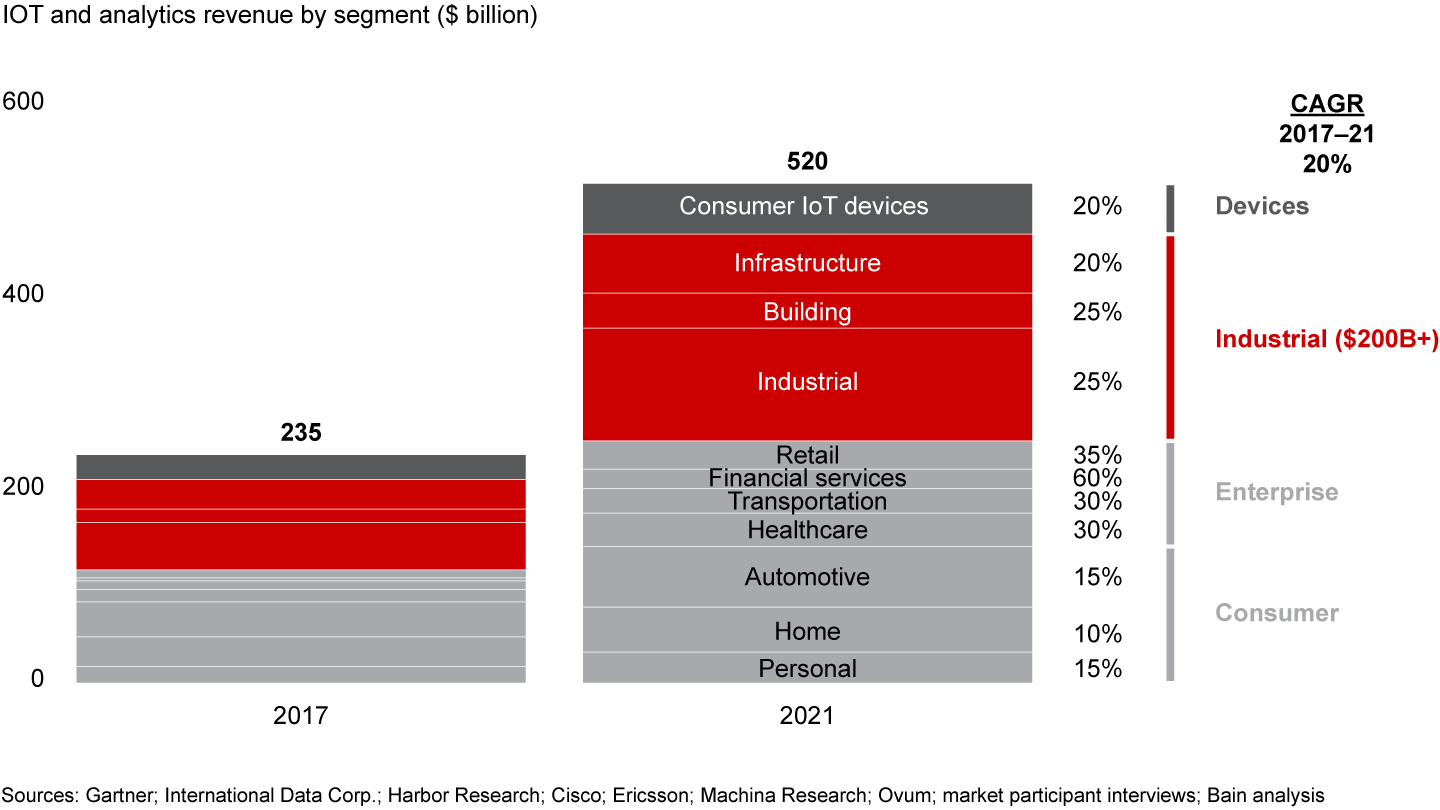
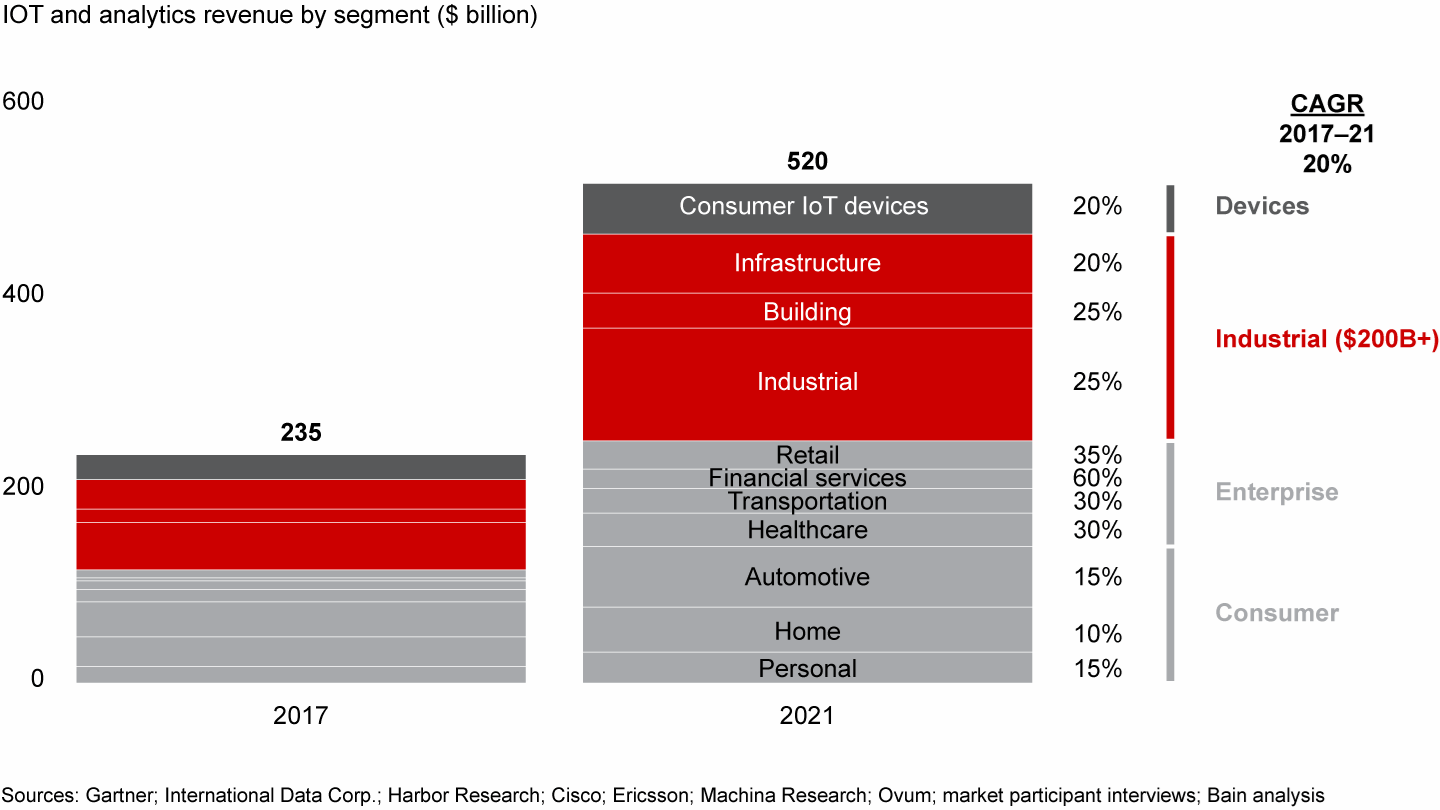
To capture that opportunity, device makers and other vendors of industrial and operational technology need to dramatically improve their software capabilities—not a historical strength for most of them. Leaders are investing heavily in acquisitions to acquire the necessary capabilities and talent (see Figure 5). Most of this M&A activity targets companies further up the technology stack—in the realms of software and systems integration—than the core capabilities of industrial companies.
Operation technology vendors are investing billions to strengthen their software capabilities
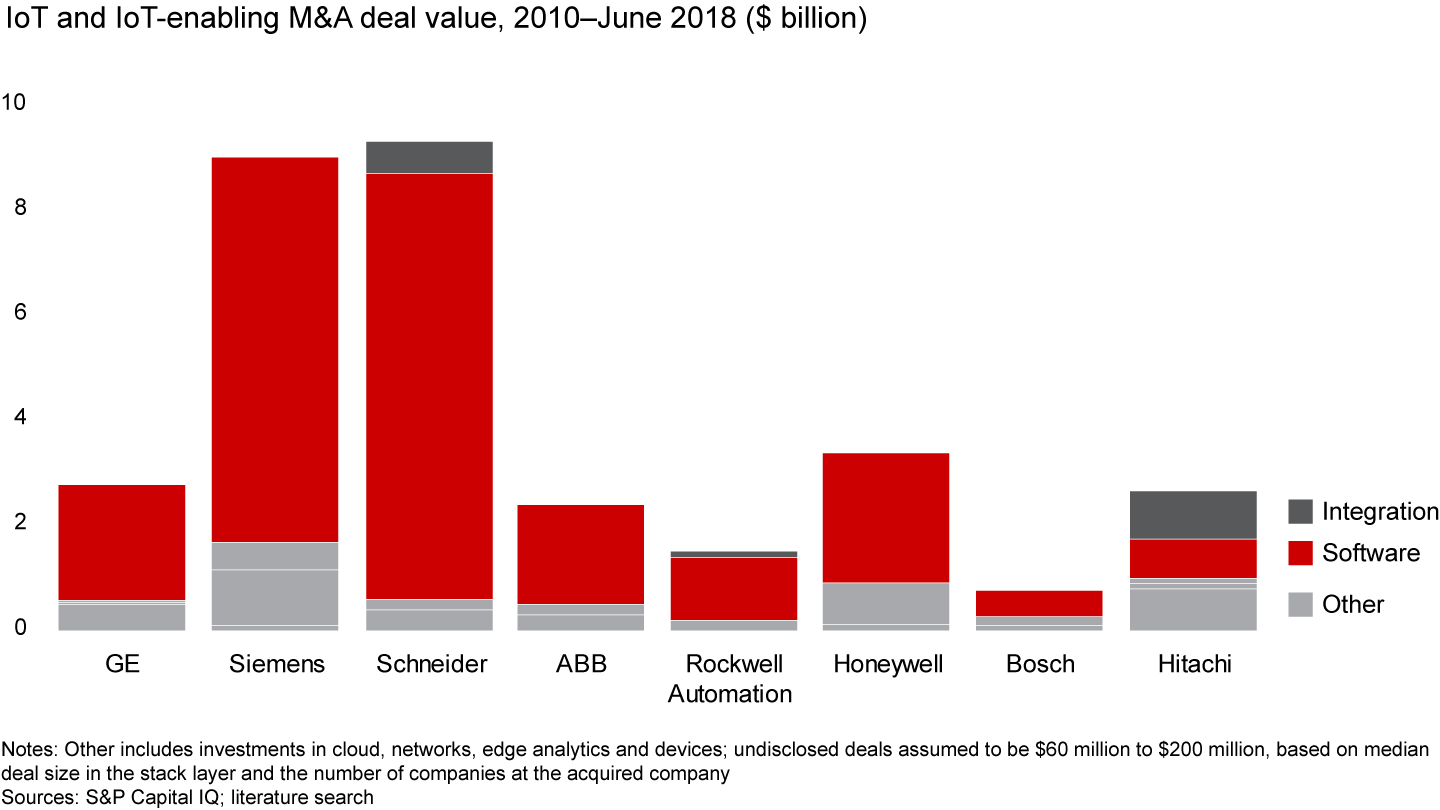
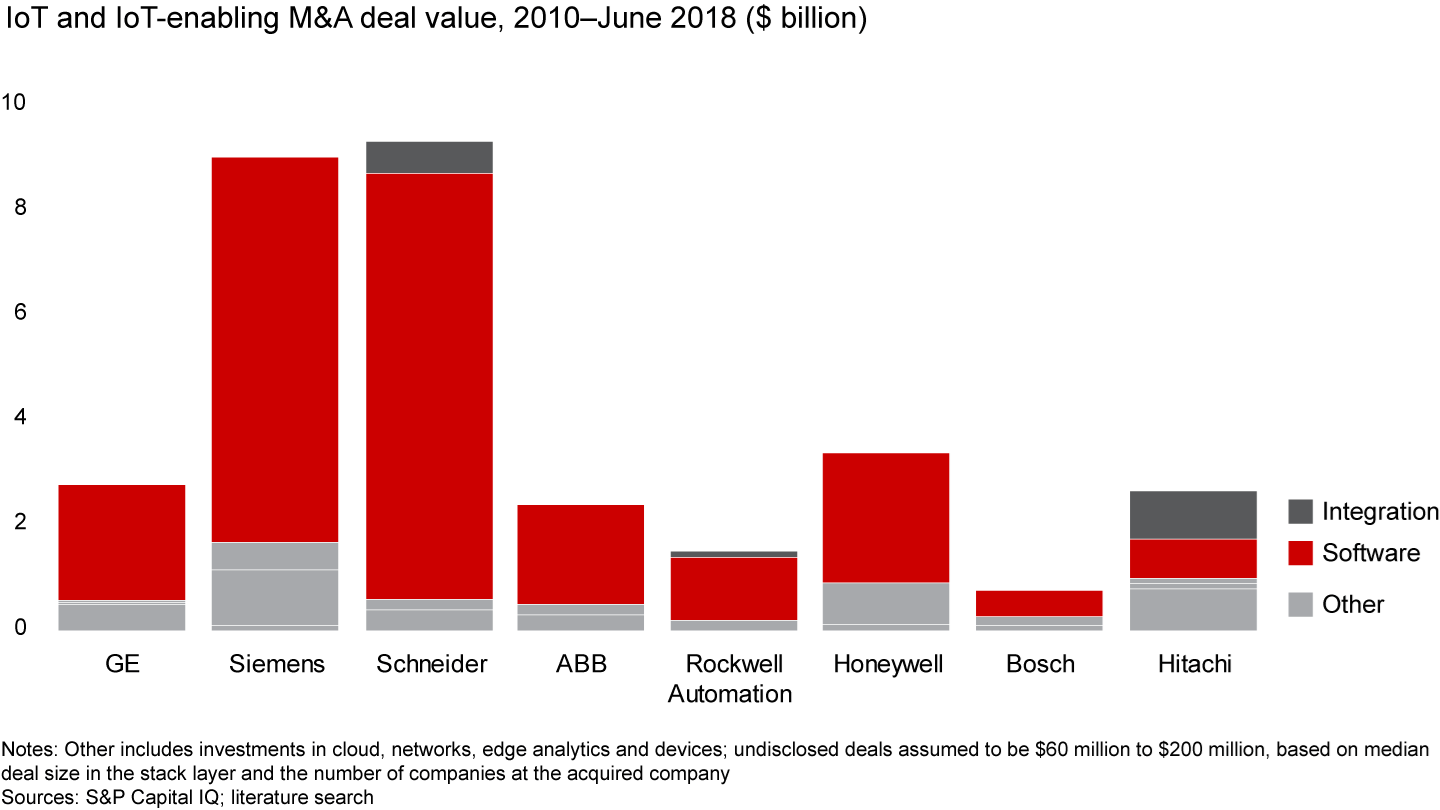
And the competitive field is crowded. Cloud service providers (CSPs) like Amazon’s AWS IoT Greengrass and Microsoft Azure are leveraging their enterprise business relationships to penetrate industrial IoT markets, and enterprise IT vendors are also developing IoT platforms. One measure of their increasing traction lies in the size of their developer networks, since they’re programming the applications that make sense of IoT data and ultimately determine the scale and scope of the platform (see Figure 6). Our research on developer networks indicates that CSPs have a substantial edge over most IoT platforms, with the exception of PTC’s Thingworx. Among industrial technology providers and device makers, most of the leaders are just beginning to catch up with GE and the CSPs. For any executive team looking to lead the market in the industrial IoT, the message to act is clear in these numbers.
All categories of vendors are competing for developers on their IoT platforms
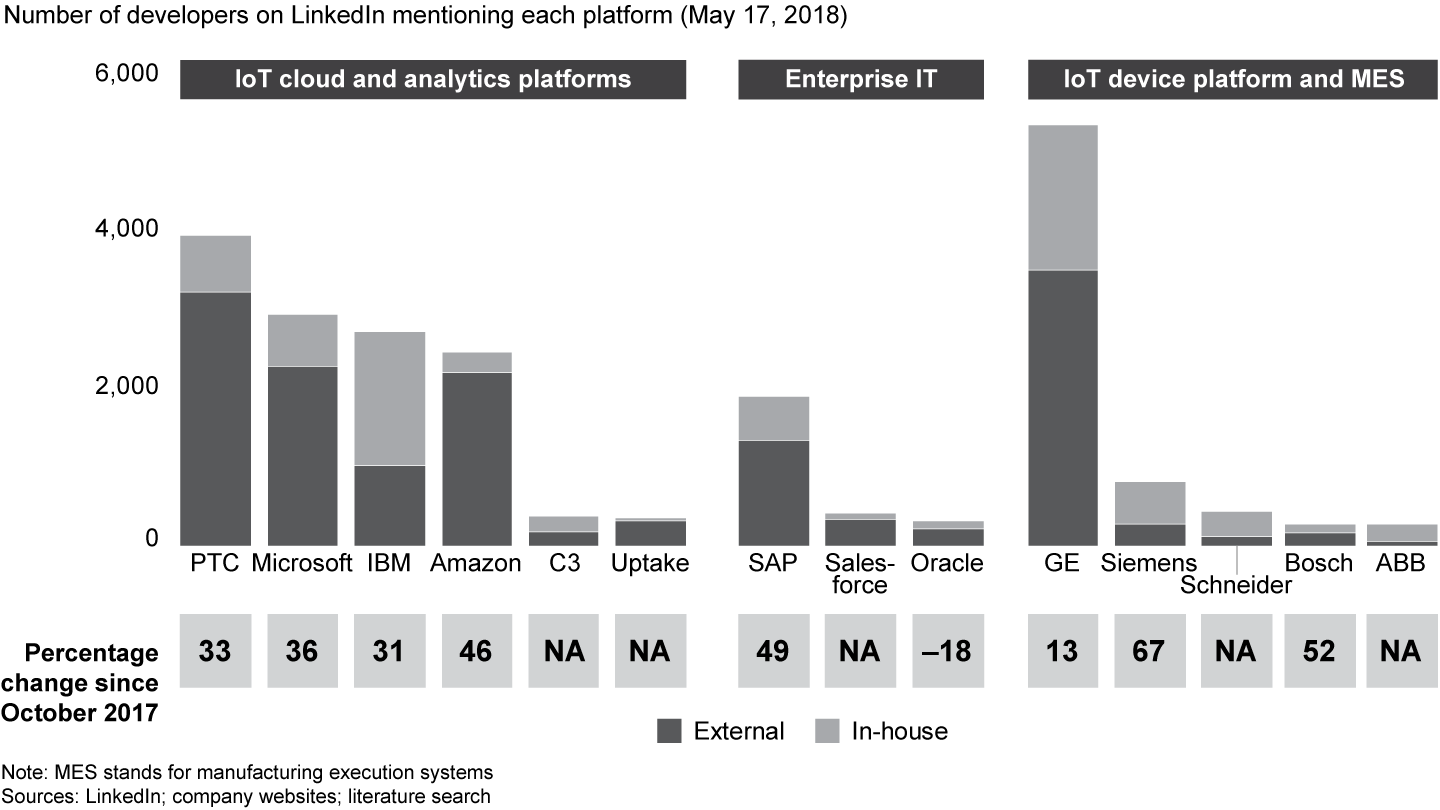
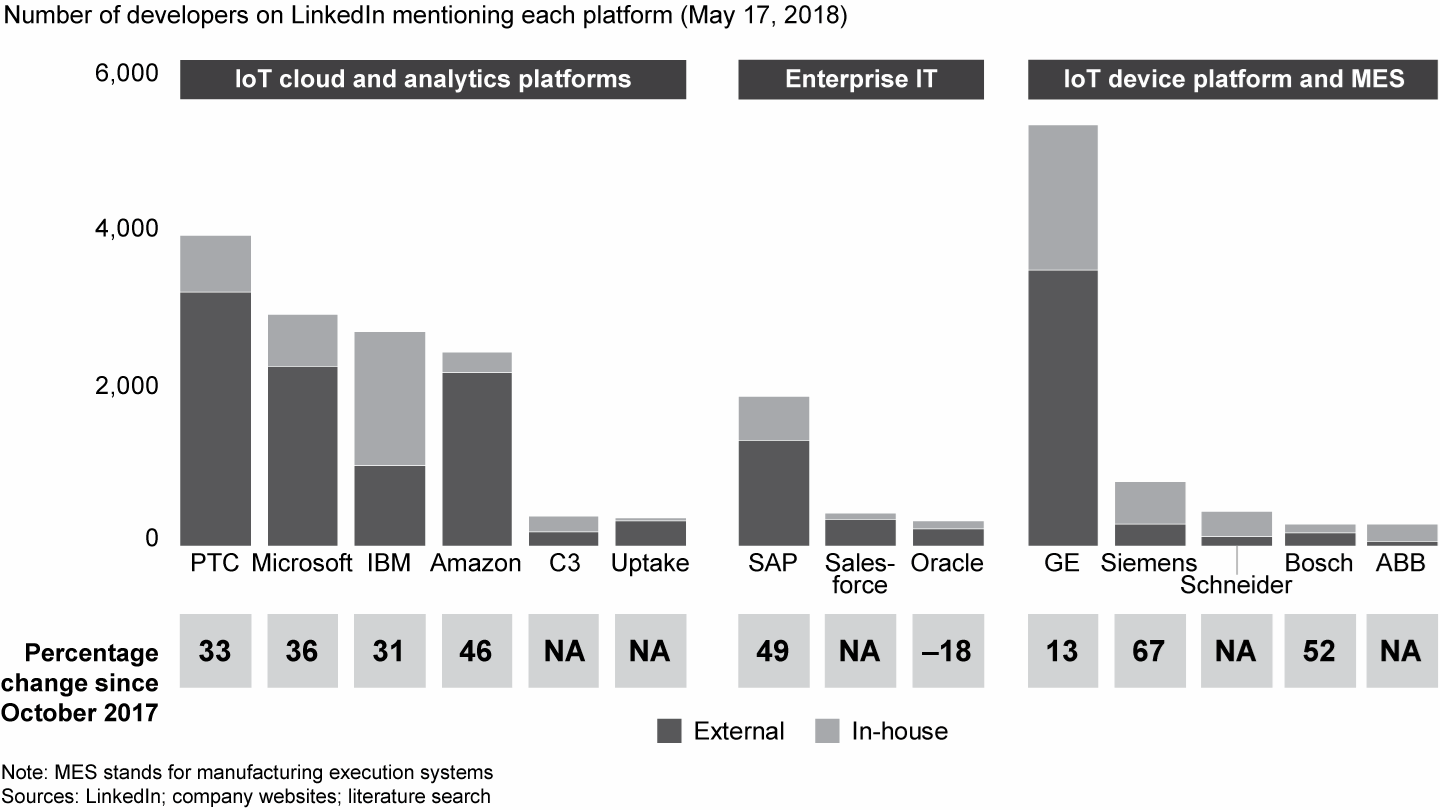
Gaining a competitive edge
To achieve scale, operational technology vendors and manufacturers will need to mobilize quickly, to ensure they gain the necessary capabilities and position themselves for long-term success. Four groups of actions can help guide the way.
- Concentrate your bets. Focus on select use cases and tackle barriers to adoption such as security, ROI, and IT and operational technology integration. Learn from proofs of concept and develop repeatable playbooks. Package IoT solutions into scalable products that you then can roll out to customers.
- Don’t try this alone. Acknowledge that you have capability gaps, and find ways to address them through partnerships. Work closely with CSPs, analytics vendors or enterprise IT vendors based on what you’re pursuing. At the same time, avoid broad and unwieldy alliances with too many players. Partnerships tend to be more effective with a selective approach based on the use case.
- Tell the CFO that break-even may take a while. Building capabilities and forging strong partnerships takes time, so commit to long investment periods. Approach the effort with a realistic view of the funding, timeline and staffing changes needed to deliver results.
- Scan broadly for new talent. Your best employees excel at their jobs, but new operating models may require different skills. Learn to identify, hire and retain the entrepreneurial talent to thrive in your evolving business model.
Finally, executives need a clear picture of what their new operating model will be. Many companies struggle to scale their successful proofs of concept amid fears of cannibalizing existing products and revenue, or out of concerns that the nascent enterprise won’t meet P&L requirements. Companies need to redesign the operating model around IoT initiatives in ways that allow internal entrepreneurs to pursue these opportunities without alienating the rest of the organization.
One way to assess your company’s readiness to scale up its industrial IoT efforts is to ask a few questions.
- Are you clear on what full potential IoT means for your company, in terms of revenues, cost and quality?
- Do you have a plan and the means to beat your competition in the industrial IoT, wherever it may come?
- Have you cracked the code to scaling IoT proofs of concept in your business?
- Do you have an effective operating model to support the execution of your plan?
Michael Schallehn, Christopher Schorling and Peter Bowen are partners with Bain’s Technology practice, based in Silicon Valley, Frankfurt and Chicago, respectively. Oliver Straehle is a partner in Zurich, where he leads Bain’s Advanced Manufacturing & Services practice in Europe, the Middle East and Africa.